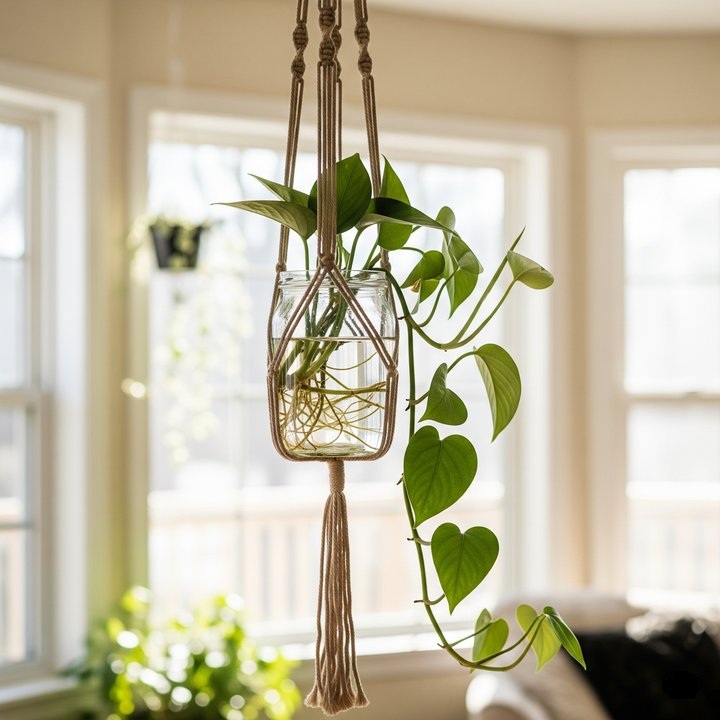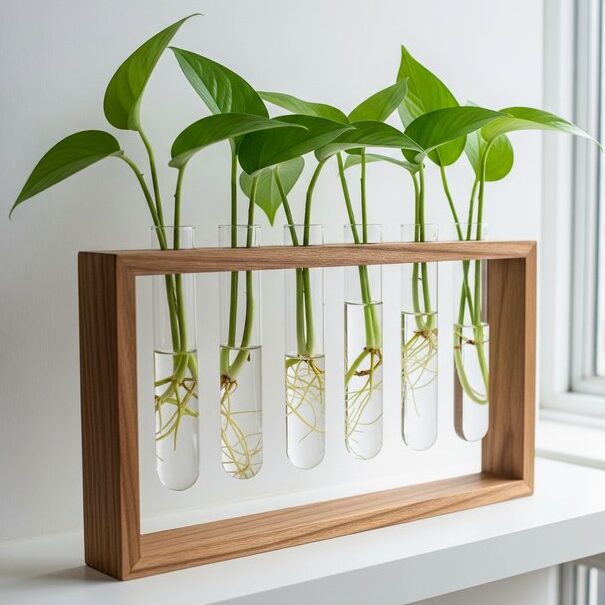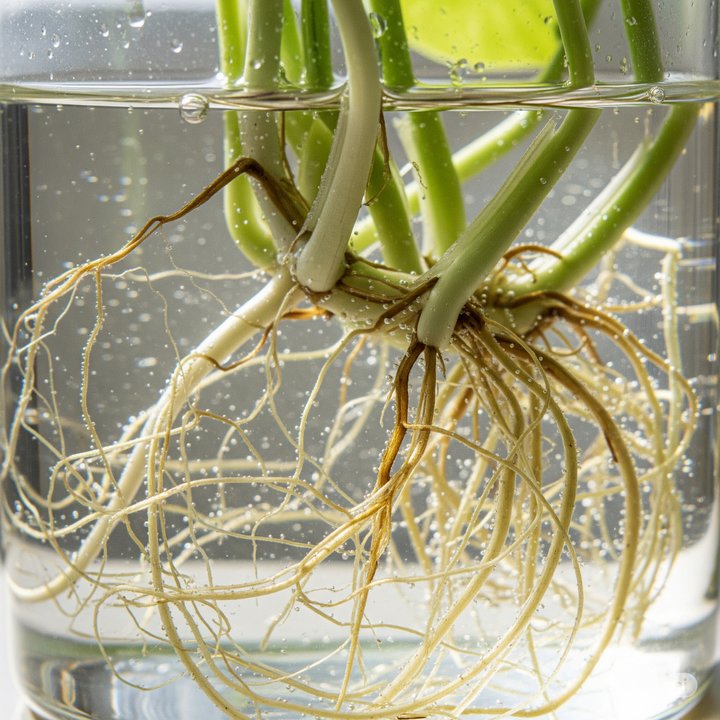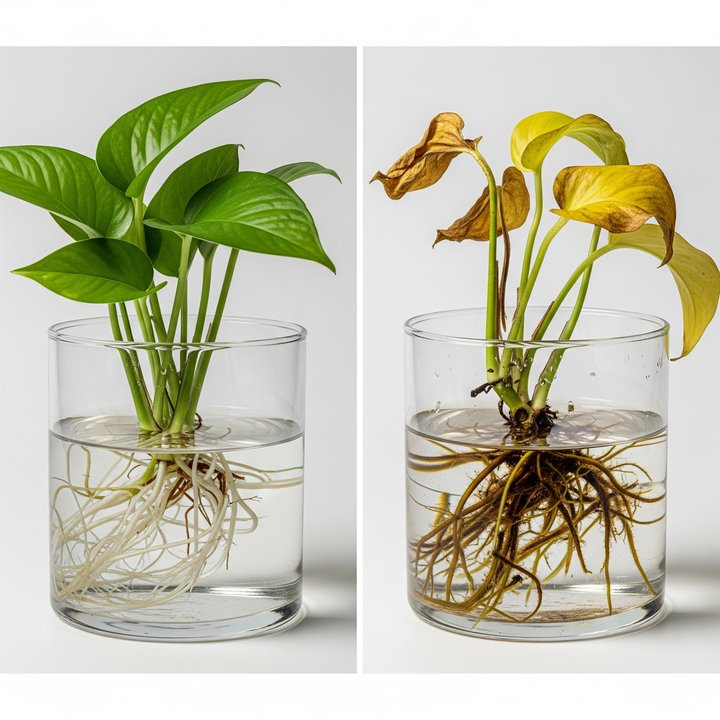Want to grow pothos in water? You’re in the right place. This easy guide covers everything—from starting cuttings to long-term care. Learn how to keep your plant healthy, fix common issues, and enjoy a mess-free, soil-free setup. It’s perfect for beginners and indoor plant lovers alike!
Why Grow Pothos in Water?

Growing pothos in water is not only easy but also a stylish way to enjoy one of the most resilient houseplants. Moreover, this method offers a clean and modern approach to indoor gardening. Whether you’re short on space or looking for a low-maintenance option, water-grown pothos is an excellent solution. In fact, it brings several benefits that make it a favorite among plant lovers.
1. Low Mess, Low Maintenance
To begin with, growing pothos in water eliminates the need for soil. As a result, there are no messy spills, no bugs, and no dirty hands to deal with. This makes it especially suitable for apartments, desks, or shelves where you want to keep things neat and minimal.
2. Easy to Propagate
Another key benefit is how simple propagation becomes. All you have to do is snip a healthy vine and place it in water — roots will begin to develop within days. In addition, watching the root system grow is both satisfying and educational, especially for beginners learning how to care for plants.
3. Decorative and Versatile
Furthermore, pothos grown in water can double as home decor. By using glass jars, vases, or even hanging test tubes, you can create a striking and modern look. As a result, the trailing vines and exposed roots provide a fresh, natural aesthetic that fits in anywhere.
4. Great for Small Spaces
Lastly, this setup is ideal for tight spaces. Because it requires minimal room, you can easily keep pothos in a bathroom, kitchen, dorm, or even on your work desk. Therefore, it’s a perfect choice for maximizing greenery without taking up much real estate.
What You’ll Need to Get Started
Before you begin growing pothos in water, gather the right tools and materials to give your plant the best chance to thrive. Here’s everything you’ll need:
Healthy Pothos Cuttings
Choose healthy cuttings with 3–4 nodes (the little bumps along the stem where roots and leaves grow). Avoid using cuttings with yellowing or damaged leaves. For best results, snip just below a node and remove the bottom leaves.
Clean Glass Containers
Any clear container will work — mason jars, drinking glasses, test tubes, or small vases. Clear glass lets you enjoy watching the roots grow and makes it easier to spot algae or debris buildup.
Water
You can use tap water, well water, or distilled water. If using tap water, let it sit out for 24 hours to allow chlorine to evaporate — this protects the roots from chemical damage.
Liquid Fertilizer
Since your pothos won’t be getting nutrients from soil, you’ll need to add diluted liquid fertilizer occasionally. A balanced all-purpose houseplant fertilizer works well — just use about 1/4 of the recommended strength.
Tools
Use clean scissors or pruning shears to take your cuttings. Make sure the blades are sharp to avoid crushing the stem, which can slow rooting.
Step-by-Step Guide to Growing Pothos in Water

1. How to Select and Prepare Cuttings
Start with a healthy pothos plant. Look for vines that are green, firm, and free of pests or disease.
- Cut a 4–6 inch stem just below a node (where the leaf meets the stem).
- Make sure your cutting includes 3 to 4 nodes.
- Remove the bottom leaves to leave at least 1–2 bare nodes that will sit underwater and develop roots.
Tip: Use clean, sharp scissors or pruning shears to avoid damaging the stem.
2. Preparing the Water and Container
Choose a clean glass container like a mason jar, vase, or test tube.
- Fill it with room-temperature water.
- If using tap water, let it sit out for 24 hours so chlorine can evaporate.
- Optionally, add a drop of diluted liquid fertilizer if your plant has been in water for a while.
Avoid metal containers — they may corrode and harm the roots.
3. How to Position Cuttings in Water
- Place the cutting into the container so that at least one or two nodes are submerged.
- Keep all leaves above the water line to prevent rotting.
- If the cuttings float, use a clip or narrow container to hold them upright.
Roots usually start forming in 7–14 days, depending on the environment.
4. Best Lighting and Temperature Conditions
- Pothos thrives in bright, indirect light.
- Avoid direct sun, which can overheat the water and scorch the leaves.
- Keep the plant in a warm room — ideally between 18°C to 25°C (65°F to 77°F).
- Avoid placing it near AC vents, heaters, or drafty windows.
Lower light may slow root growth, but pothos is adaptable
Read This:- Pothos Light Requirements: What Every Plant Parent Should Know
Long-Term Care for Pothos in Water

Once your pothos has settled into its watery home, keeping it healthy over the long term is easy with the right routine. Here’s how to make sure your plant thrives for months — or even years — in water.
How Often to Change the Water — and Why
Water in containers can become stagnant over time, losing oxygen and allowing bacteria or mold to grow. That’s why changing the water every 1 to 2 weeks is essential.
- Rinse the container and refill with fresh, room-temperature water.
- If algae or cloudiness appear sooner, change it more frequently.
- Top up the water between changes if it evaporates.
Healthy water = healthy roots.
How and When to Feed with Fertilizer
Without soil, your pothos will need nutrients added to the water.
- Use a balanced liquid houseplant fertilizer, diluted to ¼ strength.
- Add fertilizer to the water once a month or with every second water change.
- Don’t over-fertilize — too much can cause root burn or yellowing leaves.
Use clear containers so you can spot signs of nutrient buildup.
Cleaning Algae and Keeping Containers Clear
Algae may build up on glass over time, especially in bright areas.
- Rinse the container with mild soap and water (no harsh chemicals).
- Scrub the inside gently with a bottle brush.
- Rinse thoroughly before placing the plant back.
Keep algae under control to prevent root stress and maintain a clean look.
Root Pruning and Maintenance
Over time, roots may get long, tangled, or overcrowded in the container.
- Trim roots every few months using sterilized scissors.
- Cut just below a node or root clump — avoid cutting too close to the stem.
- If roots turn brown, slimy, or mushy, trim them immediately and refresh the water.
Healthy roots should be white or light tan and firm.
Signs of Healthy vs. Unhealthy Growth
Healthy pothos in water will have:
- Bright green leaves
- White or light tan roots
- Steady leaf growth
- No smell from the water
Unhealthy signs include:
- Yellowing or drooping leaves
- Dark, slimy roots
- Cloudy or smelly water
- Algae overgrowth
Troubleshooting Common Problems

Even though pothos are incredibly low-maintenance, a few issues can pop up when growing them in water. Here’s how to identify and fix the most common problems to keep your plant healthy and thriving.
Yellowing Leaves
Causes:
- Over-fertilization
- Poor water quality
- Not enough light
- Natural leaf aging (bottom leaves only)
Fix:
- Change the water and skip fertilizer for a few weeks.
- Move the plant to a spot with more indirect sunlight.
- Trim yellow leaves to encourage healthy growth.
If only one or two lower leaves turn yellow occasionally, it’s usually not a big deal.
Slimy or Rotten Roots
Causes:
- Stagnant water
- Overcrowded roots
- Lack of oxygen
Fix:
- Remove the plant and trim any mushy or brown roots.
- Rinse the healthy roots under clean water.
- Clean the container thoroughly before refilling with fresh water.
- Resume changing water every 1–2 weeks.
Healthy roots should be white or pale tan, never dark or smelly.
Algae Buildup
Causes:
- Too much direct sunlight
- Nutrient-rich water sitting too long
Fix:
- Move the container to a bright but indirect light location.
- Use an opaque or tinted glass container to block light from reaching the water.
- Scrub the glass regularly and refresh water more frequently.
Algae is not always harmful, but too much can reduce oxygen and stress the plant.
Lack of New Growth
Causes:
- Insufficient light
- No fertilizer
- Cold temperature or draft
Fix:
- Ensure your pothos gets bright, indirect light daily.
- Start a monthly fertilizing routine with diluted liquid fertilizer.
- Keep the plant away from cold drafts, vents, or windows.
Pothos grow slower in winter but should perk up in warmer months.
Can Pothos Live in Water Forever? Pros and Cons
Yes, pothos can live in water forever — but there are important advantages and limitations to keep in mind. While it’s a stylish, low-maintenance method, it may not always be the best long-term option for every plant or grower.
Advantages of Growing Pothos in Water
- Low Maintenance: No soil means less mess, fewer pests, and minimal upkeep.
- Stylish Display: Clear containers and trailing vines look clean, modern, and decorative.
- Easy Monitoring: You can see root growth, water levels, and early signs of problems easily.
- Perfect for Small Spaces: Great for shelves, desks, and bathrooms where pots aren’t practical.
- Ideal for Beginners: Simple setup and easy care make it a great option for new plant owners.
Limitations and When to Consider Soil Transfer
- Slower Growth: Pothos typically grow faster and fuller in soil due to richer nutrients.
- Nutrient Management: Water-grown plants require regular fertilizing, or they may stall or weaken.
- Root Fragility: Long-term water roots are thinner and more delicate than soil roots.
- Higher Risk of Root Rot: Poor water hygiene can lead to bacterial or fungal problems.
Consider transferring to soil if:
- You want faster growth or a bushier plant.
- You’re struggling with algae or root rot.
- You want to combine multiple cuttings into one full pot.
How to Safely Transfer from Water to Soil
If you decide to move your pothos from water to soil, do it gently to avoid shocking the roots.
- Choose a pot with good drainage and fresh, well-aerated potting mix.
- Remove the cutting from water and rinse the roots gently with room-temperature water.
- Let the roots dry slightly (5–10 minutes) to reduce transplant shock.
- Plant it in moist soil, covering the roots fully but not burying the stem too deep.
- Place the pot in indirect light and water lightly.
- Avoid overwatering for the first 1–2 weeks while roots adjust to their new medium.
Expect some temporary leaf droop — this is normal during the transition.
Best Containers and Setups for Pothos in Water

One of the best things about growing pothos in water is how versatile and decorative it can be. From simple glass jars to stylish wall-mounted displays, there are endless ways to show off your plant while keeping it healthy.
Glass Jars vs. Test Tubes vs. Decorative Vases
Glass Jars (e.g., Mason Jars):
- Easy to find and clean
- Perfect for beginners
- Offers plenty of room for root growth
- Can look bulky or plain without styling
Test Tubes or Propagation Stations:
- Sleek and modern appearance
- Great for minimalist or vertical setups
- Ideal for small cuttings
- Limited root space — better for short-term or display use
🔹 Decorative Vases:
- Add style and elegance to your space
- Available in various shapes, sizes, and colors
- Great for both single cuttings or lush trailing displays
- Narrow-necked vases may be harder to clean
Tip: Use clear containers if you want to watch root growth — but go for tinted or opaque ones if algae buildup becomes a problem.
DIY Hanging Systems & Creative Displays
Hanging Test Tube Frames:
Mount propagation tubes on wooden frames or wall shelves — great for a vertical green wall look.
Macramé Plant Hangers:
Hang jars or vases from ceiling hooks using macramé or rope for a boho vibe.
Window-Sill Setups:
Line a row of matching jars across a bright windowsill for a sunlit, indoor jungle effect.
Upcycled Glassware:
Repurpose juice bottles, candle jars, or perfume bottles to create unique plant displays with zero waste.
Floating Shelf Display:
Use wall-mounted or corner shelves to create a clean, layered look with multiple pothos jars at varying heights.
Match your container style with your home décor — and your pothos will look like a designer plant!
Frequently Asked Questions (FAQ)
Here are answers to some of the most common questions about growing pothos in water — perfect for beginners and curious plant lovers alike.
Can you use tap water or does it need to be distilled?
Yes, you can use tap water — but it’s best to let it sit out uncovered for 24 hours before using. This allows chlorine to evaporate, which can otherwise stress the roots. Distilled or filtered water is a great alternative if your tap water is hard or heavily treated.
How often should I fertilize?
Fertilize your pothos once a month using a balanced liquid houseplant fertilizer at ¼ of the recommended strength. Over-fertilizing can damage the roots, so less is more when your plant is growing in water.
What’s the best light for pothos in water?
Pothos loves bright, indirect sunlight. A spot near a north or east-facing window is ideal. Avoid direct sun, which can overheat the water and scorch the leaves. If light is too low, the plant will grow slowly and develop smaller leaves.
Can pothos survive without fertilizer in water?
Yes — but only for a while. Without fertilizer, your pothos may grow slowly or develop yellow leaves due to nutrient deficiency. If you want long-term healthy growth, you’ll need to supplement with fertilizer occasionally.
How do I know when to move to soil?
Consider moving to soil if:
- Growth has stalled for a long time
- Roots are too large for the container
- You want a fuller, bushier plant
- The plant seems unhealthy despite clean water and fertilizer
To transfer, plant it gently in moist soil and avoid overwatering for the first couple of weeks.
Conclusion
Growing pothos in water is one of the easiest and most rewarding ways to enjoy this beloved houseplant. With just a few simple tools and a bit of care, you can create a beautiful, low-maintenance display that thrives without soil.
To recap:
- Use healthy cuttings with 3–4 nodes
- Keep water fresh and containers clean
- Fertilize lightly once a month
- Place in bright, indirect light
- Monitor roots and trim as needed
Whether you’re short on space or just love the clean look of plants in glass, pothos in water is perfect for beginners and plant lovers alike.
Give it a try! Let us know how your water-grown pothos is doing — share your experience, photos, or ask questions in the comments below. We’d love to hear from you!
Resources
- University of Florida IFAS Extension – Pothos Plant Care
- Missouri Botanical Garden – Epipremnum aureum Profile
- Houseplant Resource Center – Growing Pothos in Water

